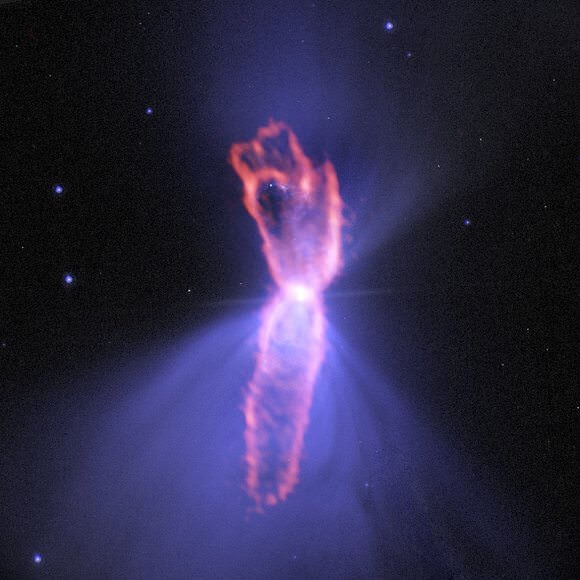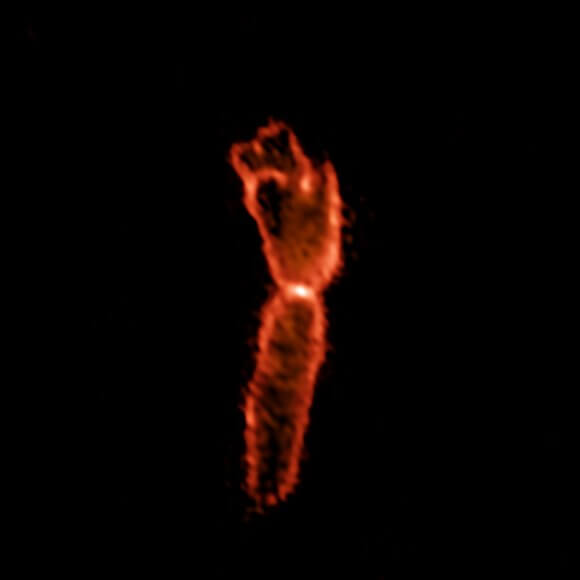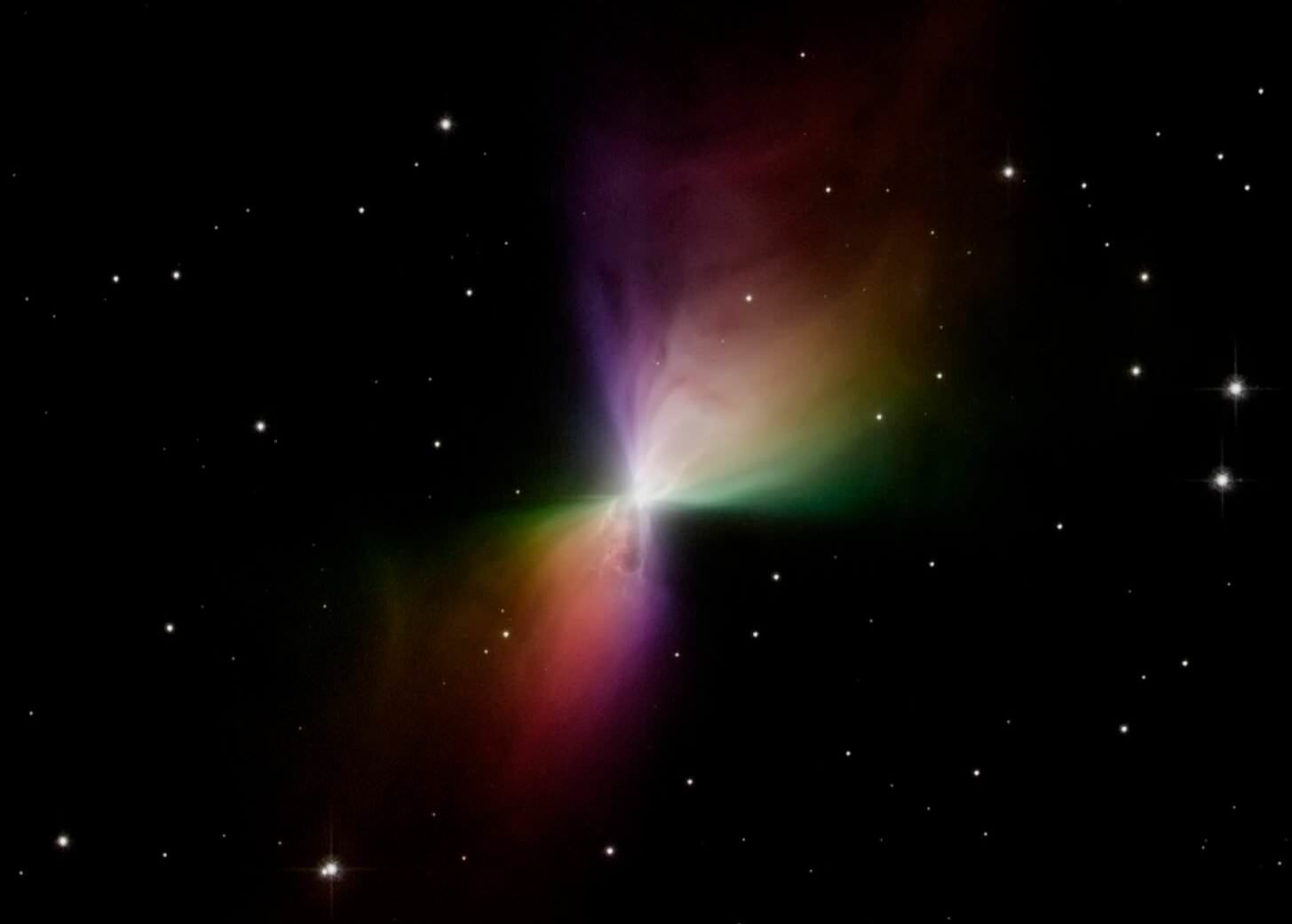The Boomerang Nebula, a proto-planetary nebula that was created by a dying red giant star (located about 5000 light years from Earth), has been a compelling mystery for astronomers since 1995. It was at this time, thanks to a team using the now-decommissioned 15-meter Swedish-ESO Submillimetre Telescope (SESTI) in Chile, that this nebula came to be known as the coldest object in the known Universe.
And now, over 20 years later, we may know why. According to a team of astronomers who used the Atacama Large Millimeter/submillimeter Array (ALMA) – located in the Atacama desert in northern Chile – the answer may involve a small companion star plunging into the red giant. This process could have ejected most of the larger star’s matter, creating an ultra-cold outflow of gas and dust in the process.
The team’s findings appeared in a paper titled “The Coldest Place in the Universe: Probing the Ultra-cold Outflow and Dusty Disk in the Boomerang Nebula“, which appeared recently in the Astrophysical Journal. Led by Raghvendra Sahai, an astronomer at NASA’s Jet Propulsion Laboratory, they argue that the rapid expansion of this gas is what has caused it to become so cold.

Originally discovered in 1980 by a team of astronomers using the Anglo-Australian telescope at the Siding Spring Observatory, the mystery of this nebula became apparent when astronomers noted that it appeared to be absorbing the light of the Cosmic Microwave Background (CMB). This background radiation, which is the energy leftover from the Big Bang, provides the natural background temperature of space – 2.725 K (–270.4 °C; -454.7 °F).
For the Boomerang Nebula to absorb that radiation, it had to be even colder than the CMB. Subsequent observations revealed that this was in fact the case, as the nebula has a temperature of less than half a degree K (-272.5 °C; -458.5 °F). The reason for this, according to the recent study, has to do with the gas cloud that extends from the central star to a distance of 21,000 AU (21 thousands times the distance between Earth and the Sun).
The gas cloud – which is the result of a jet that is being fired by the central star – is expanding at a rate that is about 10 times faster than what a single star could produce on its own. After conducting measurements with ALMA that revealed regions of the outflow that were never before seen (out to a distance of about 120,000 AUs), the team concluded that this is what is driving temperatures to levels lower than that of background radiation
They further argue that this was the result of the central star having collided with a binary companion in the past, and were even able to deduce what the primary was like before this took place. The primary, they claim, was a Red Giant Branch (RGB) or early-RGB star – i.e. a star in the final phase of its life cycle – whose expansion caused its binary companion to be pulled in by its gravity.

The companion star would have eventually merged with its core, which caused the outflow of gas to begin. As Raghvendra Sahai explained in a NRAO press release:
“These new data show us that most of the stellar envelope from the massive red giant star has been blasted out into space at speeds far beyond the capabilities of a single, red giant star. The only way to eject so much mass and at such extreme speeds is from the gravitational energy of two interacting stars, which would explain the puzzling properties of the ultra-cold outflow.”
These findings were made possible thanks to the ALMA’s ability to provide precise measurements on the extent, age, mass and kinetic energy of the nebula. Also, in addition to measuring the rate of outflow, they gathered that it has been taking place for around 1050 to 1925 years. The findings also indicate that the Boomerang Nebula’s days as the coldest object in the known Universe may be numbered.
Looking forward, the red giant star in the center is expected to continue the process of becoming a planetary nebula – where stars shed their outer layers to form an expanding shell of gas. In this respect, it is expected to shrink and get hotter, which will warm up the nebula around it and make it brighter.
As Lars-Åke Nyman, an astronomer at the Joint ALMA Observatory in Santiago, Chile, and co-author on the paper, said:
“We see this remarkable object at a very special, very short-lived period of its life. It’s possible these super cosmic freezers are quite common in the universe, but they can only maintain such extreme temperatures for a relatively short time.”
These findings could also provide new insights into another cosmological mystery, which is how giant stars and their companions behave. When the larger star in these systems exists its main-sequence phase, it may consume its smaller companion and similarly become a “cosmic freezer”. Herein lies the value of objects like the Boomerang Nebula, which challenges conventional ideas about the interactions of binary systems.
It also demonstrates the value of next-generations instruments like ALMA. Given their superior optical capabilities and ability to obtain more high-resolution information, they can show us some never-before-seen things about our Universe, which can only challenge our preconceived notions of what is possible out there.
Further Reading: NRAO


Very helpful article – many thanks.
One typo tho. For “who’s expansion” read “whose expansion”